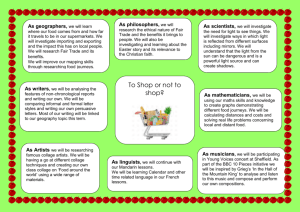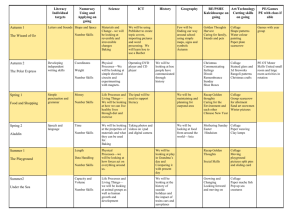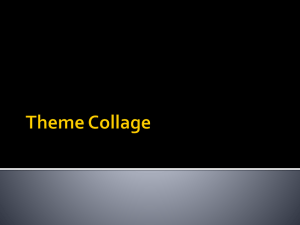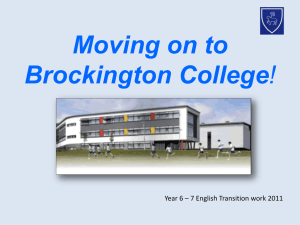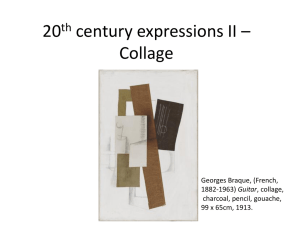how to make a collage with paper elements
advertisement
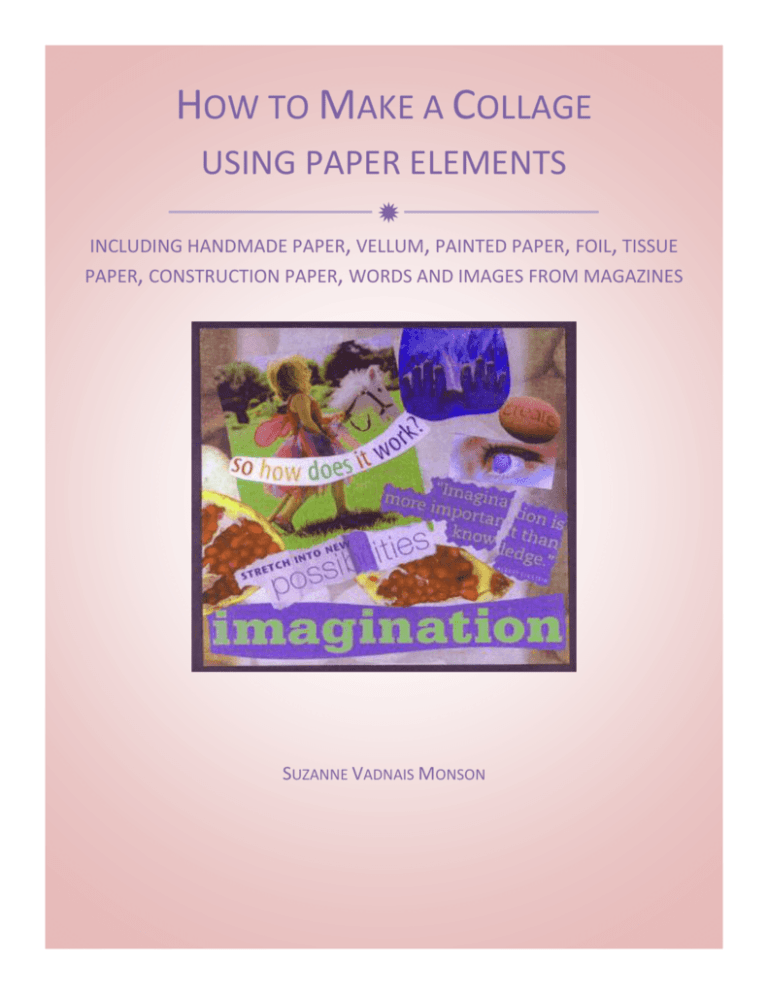
HOW TO MAKE A COLLAGE USING PAPER ELEMENTS INCLUDING HANDMADE PAPER, VELLUM, PAINTED PAPER, FOIL, TISSUE PAPER, CONSTRUCTION PAPER, WORDS AND IMAGES FROM MAGAZINES SUZANNE VADNAIS MONSON table of contents dive in! an introduction page 3 copywrite rules for collage artists page 4 step one: choose a theme page 5 step two: choose a size page 5 step three: choose a surface page 6 step four: assemble the tools page 9 step five: gather the images page 12 step six: create the collage page 14 step seven: protecting your work page 18 collage art resources page 25 2 How to Make a Collage Dive in! Remember what it felt like to make your very first collage out of the cool pictures you collected? Maybe you wanted to celebrate a special event like a birthday or a graduation or a wedding. Or maybe you wanted to make a collage out of pictures of art you were collecting and your first collage was a fun collection of these images. Maybe you wanted to make a statement with your first collage, like saying something about saving the environment or promoting peace or how cool it was to like a band you were crazy about! Whatever it was that inspired you to sit down and arrange those first images on paper and create a collage is probably the very reason you are looking at making an art collage today. This post is designed to give you all the tips, tools and techniques you need to make an art collage out of paper elements. This type of collage has specific techniques to follow to ensure professional results and I will walk you through the steps to using these techniques to help you master this art making process quickly and easily! What’s great about making a collage from found images is that there is so much material you can use to build your finished work of art. You can create a collage using images and words from magazines, from books, from maps, from newspapers, from photos, from digital images of 3D objects you photograph and print out on paper, from images of your drawings and paintings you print out and photocopy. And you can use fun art papers from collage kits, like this! You can make your own paper, create your own images, and use any kind of printed paper or decorative paper that you have in your studio. I think of collage art as the ultimate in recycling because it allows me to reuse so many items I would normally toss out in the recycling bin. How to Make a Collage 3 the rules for collage and copyright If you are planning on publishing or selling your collage art there are some copyright rules you need to be aware of and do your best to follow. I hired a copyright attorney when I published a deck of collaged cards. He used a very careful legal process to determine if the work I had created was a new work of art and if I had used any one image from a published source too much in my collage. I highly recommend you consult a lawyer if you are thinking about getting into making a lot of collage art pieces that use work that is protected by copyright. Here are two great links to get you started in researching copyright law as it applies to collage work: Copyright for Collage Artists http://www.funnystrange.com/copyright/index.html Funnystrange is a website run by graphic designer Sarah Ovenall that is jam-packed with helpful information. She has some fabulous work here too. Check out her Art Car! Here is a link to NOLO’s website page on when the use of copyright material is acceptable: http://www.nolo.com/legal-encyclopedia/fair-use-rule-copyright-material-30100.html Nolo is the integration of some of the Internet’s first legal sites, including Nolo.com, Divorcenet.com and AllLaw.com. These sites were combined with the ExpertHub technology platform in 2011 to form the Nolo Network. Nolo began publishing do-it-yourself legal guides in 1971. In the 40 years since it’s founding, Nolo evolved with technology, developing do-ityourself software and building Nolo.com into one of the Internet’s leading legal websites. Learn more about Nolo’s history. Basically it comes down to asking and answering questions like this: Are you creating a new work or copying someone else’s work? This becomes a matter of percentages. How much of your collage is made up of a single image? Does this image have a copyright? Is any image you are using so recognizable that the percentage of the image being used doesn’t matter? Are you creating a collage that makes the work you are using look bad? It is best to assume that words and images taken from published books, magazines, calendars; the Internet, etc. do have an active copyright and create with this in mind. 4 How to Make a Collage step one: choose a theme To begin, choose an idea or theme for your collage. For instance, do you want to make a collage about an idea, like imagination? Or do you want to make a collage about a thing, like the forest? Maybe you want to make a collage about farming, or swimming, or loving a child…or some other activity! Just as with a drawing or a painting, you can choose to make a collage about anything you find interesting. step two: choose a size Ok, so you have your theme in mind. Next, you want to decide how BIG to make the collage. I like to use large long sheets of tag board or art board that measure 18” x 24” for my paper collage work. It looks like this: This surface is ideal for a collage that is made of words and images clipped from magazines because the paper used to print magazines is very thin. If your surface isn’t smooth, your images will not lay flat on the page. They will wrinkle and possibly tear if the surface has a lot of texture. Another reason I often choose to use ta smooth art board for my paper collage art is that it is very inexpensive. This means I can make a lot of collages very affordably! You can pick up 100 sheets of 18” x 24” Pacon Storybook 2-Ply tag board from Blicks for $20.50. This will give you a lot of sheets to play with so you don’t have to worry about wasting money if you mess up. If you end up with a collage you don’t like, it’s not expensive to start fresh with a new piece of tag board. Another nice thing about working with tag board is that it is easy to cut with a scissors to create any size or shape you like, including unique shapes like stars or circles or frames to go around another image or funky abstract shapes. It’s all up to you and what you need for the piece you are making today. How to Make a Collage 5 step three: choose a surface There are many other surfaces you can use for collage. Here are some of my favorites! This assortment of colored art board offers a nice range of colors if you want to begin your collage on a colored surface. The sheets are 9” x 12” and you can pick up a package of 16 for under $5.00. • Foam board Foam board is a nice lightweight option for a collage surface that offers a very rigid surface for building your collage without adding weight. Foam board is also very smooth and fairly inexpensive. A package of 12 pieces 3/16” thick and fairly large (16” x 20”) will run around $30. Foam board also comes in very large sizes! Blick sells a package of 12 sheets measuring 46” x 96” for $582. If you want to make very large collages this is the way to go. I have used large foam core board for classroom collages when I taught art in elementary schools. This is a perfect surface for a group project because it allows everyone to have a little room to work without crowding. They are lightweight and easy to hang for display. 6 How to Make a Collage Primed Canvas Panels Canvas Panels are a step up from Foam board in sturdiness. Each panel is a solid sheet of canvas that has been glued to a rigid surface and them sealed with gesso. They offer a slightly more textured surface than tag board or foam core. One way to tone down the texture when using a canvas panel is to apply a thin layer of acrylic paint or glue, like mod podge, to the panel. Let this dry completely before assembling your collage materials. A pack of 24 panels measuring 9” x 12” will cost about $18.00. • Pre-stretched canvas This is a great surface to use for the collage work you plan to sell. The canvas does have a little texture, which can easily be toned down by applying a layer of paint or glue and letting it dry. Pre-stretched canvas is lightweight and comes in a wide range of sizes. It is also one of the spendiest options for a collage surface! A single 9” x 12” canvas will cost about $8.00. How to Make a Collage 7 • Art Board I generally use Art Boards for my surface when I plan to sell the collage I am making. Art Board is a rigid archival surface that is used for a variety of media and techniques – from drawing to painting and collage. I often want to add paint elements to my collage work so I will choose an art board because it gives me a little more flexibility with materials. Art boards come in a variety of colors, finishes and sizes. I like to use the 16” x 20” boards, which cost around $3.00 a sheet. These are the specific types of art boards I use most often for the collage work I sell: 8 Cold or hot press watercolor boards. They have a little texture, which is just what I want for some of my collage work with a painted background. Black drawing art boards. This has deep black pigmentation and offers a slightly textured surface. Bristol plate art boards are super smooth and very rigid. This comes in a natural white color. Pure white drawing art boards are that perfect white I sometimes want for a pristine collage background. How to Make a Collage step four: assemble the tools These are the tools I use to make a collage with paper elements. • This blue plastic tool is made by 3M. Unfortunately I can’t find it for sale anywhere! I’ve had this one for over 20 years. I have a friend who works for 3M that is doing some digging to see if she can find any. I’ll keep you posted with updates if I have any luck finding it. If you find it for sale please let me know! It is my favorite tool for smoothing paper to any surface. The tool is about 4 inches wide, which makes it the perfect size to fit in your hand. The two ridges act as little ledges to give your fingers a place to grip. I use this tool to smooth glued paper to the surface. It seamlessly adheres the paper to the surface with no wrinkles. • Foam Brayer This soft but dense foam brayer is ideal for all collage adhesive techniques using paper. It features a plated steel handle and a solid wood core under the heavy foam that allows for smooth rolling. The handle opens for easy washing or replacement of the foam roller. The brayer is 4” wide and sells for under $8.00. It gives a little when pressure is applied and easily smooths paper onto any surface without wrinkling. In light of the fact that I can’t recommend a source for the 3M tool, this is a good second choice. And it can be used for other types of art projects. Especially printmaking! If you are only going to get one tool, I recommend this brayer. How to Make a Collage 9 • Scissors It is important to have a sharp scissors for making a paper collage. I use large and small Fiskars scissors. The smaller scissors is for making precise cuts around little words or images. The larger scissors is for cutting everything from large pieces of magazine paper to sheets of tag board. • Adhesive I prefer to use glues that require very little water for creating a paper collage. There are many different brands you can use so don’t feel that these are the only kinds that work. These are simply the ones I use! . • Elmer's X-TREME School Glue Stick is specially formulated to work on bigger, tougher projects and it is perfect for collage because of its extra staying power. Some cheaper glue sticks lose their hold causing elements to lift off of a finished collage. This glue stick features an extra-strength formula that works on a variety of surfaces such as paper, photos, wood, fabric, craft materials, foam board, cardboard, and much more. 1 0 How to Make a Collage • YES! Stickflat Glue This all-purpose, layflat, white glue won't wrinkle paper. Many professionals, including bookbinders, printers, libraries, greeting and art trading card makers, use it. Yes Stikflat Glue is an acid-free, smooth flowing adhesive, and it is permanently flexible. It is low odor and easy to cleanup. This glue has a thick paste-like consistency that helps keep thicker paper bits tacked down on a collage. I apply this with a stiff acrylic fiber paintbrush. • Spray Adhesives When it comes to covering a lot of paper with glue for a collage, you can’t beat a spray on adhesive. 3M Spray Mount bonds practically any lightweight material instantly, yet allows work to be lifted and repositioned. This spray adhesive requires only one surface application. Bonds do not yellow, nor do they become brittle or flaky. 3M Super 77 forms a slightly stronger bond for things like small pieces of foam board that can be used to create dimension in a paper collage. Use Super 77 on the foam board, adhere it to the collage surface, and add the paper elements to the top of the foam board to give it a little “pop” up off of the surface. Elmers Craft Bond is another great spray adhesive for paper that is repositionable. It is perfect for thinner vellum types of paper; it doesn’t bleed through, it dries fast and clear. How to Make a Collage 1 1 step five: gather your images! The real fun begins when we collect the materials we want to use for a collage. I have a process for priming my imagination to gather images for my collages. I brainstorm on a sheet of paper to get the ideas flowing before I even start looking for images to use. Here’s how it works: Let’s say the theme for my collage is “making a fresh start”. I have an idea that what I want to look for will be images and words that follow this stream of thought: an open field, a boquet of flowers, a beach, people laughing, a person diving into water, a runner at a starting block for a race, the first day of school, first day on the job, a wedding, a graduation, retirement, a summer vacation, a new car, a new house, a phoenix rising from the flames; words that talk about beginning, excitement, diving in, going all out, having faith, dreaming big, trusting your instincts, following hunches, looking for signs, believing, magic, feeling confident, feeling alive, feeling nervous, breaking free, relaxing into fresh possibilities. Next I search through a stack of magazines and see what I can find. When I find something I like I tear out the whole page and create a pile. I use a large envelope or a file folder to store the images. I label it so I can keep track of the theme the images belong to. It is rare to use all of what you collect in one collage. Make it easy to find the images later by giving the collection a good descriptive name. 1 2 How to Make a Collage Here are some of the files I’ve created for my collage words and images. As you create more and more collages you will want to have a way to save the files of words and images you are collecting. Having a general theme title for the images will help you file them. I group things like “fresh start” and “dream big” in a hanging folder I label “Playful”. I keep my hanging file theme titles simple. Often just one word will do: celebrations, angels, Xmas, challenges, flowers, women, men, children, landscapes, fresh starts, etc. This way I can group a lot of specific themed folders into one hanging file folder. Portable storage boxes or file cabinets are a perfect way to store your image and word collections. Use tabs to create labels by theme or subject to help you keep your files organized. It is helpful to put these labels in alphabetical order inside the file system to help quickly navigate to a specific theme. I find that using this file system frees me up to collect images and words without getting overwhelmed, which is what used to happen when I first started collaging. It’s a funny kind of art supply, these pieces of paper with images that I hope to use to create a work of art. Today I have three storage boxes for my collage words and images! The beauty of this system is that as soon as I find something I can store it and easily access it again when I am ready to put it into a collage. I used to lose images, or put them places I couldn’t remember, and this was so frustrating. That experience helped me find ways to keep all of the little bits and pieces organized. It truly makes for happier collaging! Find a system that works for you and use it. It will save you lots of time and frustration! How to Make a Collage 1 3 step six: create your collage…lay it all out Once you have some material to work with, spread it out on a large surface like a table or on the floor if you need a lot of room. Survey what you have. If you see enough to get started, dive in. If you think you need more, keep looking. To begin laying out your collage identify the main images you want to use and play with some different ideas about where to put the images. Something to consider first: Do you want a coordinating image or color for your background? If so, put this down first. I sometimes use color photocopies of my paintings and artwork for backgrounds in my collages. I use photocopies because they are thinner and easier to work with than the originals. I also like that using copies allow me to work with my original art without destroying the original piece in the process. Color copies give the collage artist greater access to images. Anything we want to use like a photograph, money, birthday candles, rocks, fabric, yarn, plants, animals, lots of 3D things, can be scanned or digitally photographed and turned into a paper image that can be included in a collage! If you want a background, start with this. Then keep adding pieces, looking for unique ways to combine them and get them to work together. For instance, let’s say you are working with the idea of a phoenix rising from the flames for the collage but you don’t have any pictures of a phoenix or flames. How would you create these images? One way to do this is 1 4 How to Make a Collage to rip up some flame colored strips of paper and arrange them in a fire like pattern on the tag board. Another way to do this is to create flame like images that aren’t quite flames but have the feeling of movement captured in a flame. For instance, I am working on a collage right now about starting fresh that uses large leaf-like shapes to suggest a life force rising off of the page to give birth to a new beginning. Here is the beginning of this collage: To this beginning I will add images that I would like to see rising from the leaves, images that capture my idea of the fresh start I am experiencing in my life today. I’m not really sure what they will be yet. I will look through my image files and see what I have to play with! Often a collage takes on life as you work with the images and words. Enjoy this and give yourself time to let the ideas flow. It helps to set up as much of the collage as you can and then take a break. Come back to the piece the next day and see what you think. Make any changes that come to you. How to Make a Collage 1 5 Only you will know when you are finished. A good way to tell if you are done is to look at you brainstorming sheets again. Then look at your collage. Does it capture what you had in mind? If it does, you’re done! If it doesn’t, figure out what’s missing. Is it in your image and word files? If so, work it into your collage. If not, go back to the drawing board with some magazines. This time try looking in some magazines you didn’t use the first time. I decided I wanted something that felt like a creative explosion of possibility as a background. Luckily I used thick fabric for the leaves! This allowed me to peel up the leaves and tuck the background underneath. 1 6 How to Make a Collage I found a bunch of images of girls and women showing playfulness, possibility, and creative expression and placed them to emerge from the leaves. Then I found Tinkerbelle with her magic wand and placed her in the corner to suggest a touch of magic is at play. This one piece really pulled my idea together. Here is the finished collage! I added some Sparkle Mod Podge to the leaves to give them more of a shimmering finish. I want the feeling of something magical coming out of the leaves and reaching up to the sky. I chose a few simple words for this piece, focusing on my main theme: “Believe in the magic of FRESH STARTS” dominates the center, while Tinkerbelle is saying: “here we go!” on the right side. She is the one setting this whole process of emergence in motion. I was lucky to find words and images that worked perfectly for this piece. Sometimes I’m not so lucky. When this happens you will want to make some alterations to the images you find to turn them into the perfect pieces for your collage. This is something I am just beginning to explore in my collage work and I am very excited to give it a try. Here is a link that will step you through how to alter an image found in a magazine to transform it into something perfect for your collage. My friend and sister collage artist Susanne Skenne told me about this cool website! How to Make a Collage 1 7 http://www.freewebs.com/agnestheredtutorials/gessomagimages.htm wrapping it up When you’re done with the collage take a digital picture or scan of it. A digital image of the collage will be a great resource for sharing your work online and it serves as a back-up copy of the collage. I do this before I laminate the collage because once a piece is laminated it can be too shiny when photographed. If you want to share prints of your collage, digital files make it easy! You have so many options: e-mail a j-peg, print an image on a personal inkjet printer or e-mail a j-peg of the image to a printer to have the collage professionally printed. Next, it’s time to think about protecting your finished collage. step seven: protect your work 1) crystal clear bags Crystal Clear Bags™ are a great way to protect a finished collage. They come in hundreds of sizes, are very affordable, and they will not wrinkle or dimple the collage elements like so many other protective options can. Mod podge or any other paint on sealer will always be a challenge to the paper crafter because it has a tendency to leave the paper with a ripple or a bunch of ripples! There is nothing worse than a perfect collage ruined by a wavy finish. Crystal Clear Bags are my top choice for protecting my collages today. They do not actually touch the surface of the finished collage. They are thick clear plastic envelopes with top flaps and re-sealable adhesive strips, which allow the bag to be opened and resealed in necessary. Using a Crystal Clear Bag is as easy as inserting an item, peeling the adhesive cover strip off to expose the sticky adhesive and then folding and pressing the flap to the bag to seal it. They look very professional and create a work that can easily be mounted on a wall or framed. You can find these online at www.clearbags.com 1 8 How to Make a Collage Here is a collage preserved in a crystal clear bag: How to Make a Collage 1 9 2) Laminating film I have used laminating film to protect my paper collages for many years because it creates a permanent professional finish. However, I have begun to rethink this because I’ve found that over time the film can lift and stretch due to heat and humidity loosening the sticky adhesive. This creates ripples in the film and causes unappealing waves in the surface of a paper collage. I’ll add an example at the end of this section so you can see what I am talking about. The upside of using laminating film is that it is a transparent, tear-resistant, permanent adhesive film that's quick and easy to use: just peel and apply! It gives a paper collage a fabulous finish. Laminating film comes in a variety of sizes, but it is easiest to use in sheets measuring 12” x 18” or smaller. If you want to use larger sheets of laminating film find someone to help you. It can be a little tricky to keep the laminating film taught! A helper can secure the film in place on the table while you place the collage on the film. The trick to using laminating film is to get the film in place without lifting any of the pieces of paper off of the collage surface. A trick I have used with success is to place the film on a table with the finished (non sticky) side down. Peel the sticker backing off of the laminating sheet and leave it on the table with the sticky side up. Center your collage over the laminating sheet and press it down in one smooth motion. Turn the collage over and check for any wrinkles or folded paper. Gently lift the film off if you need to correct anything. When you are happy with how the laminating film is placed, turn it back over and press firmly with both hands to marry the film to the collage by rolling a foam brayer or other smoothing tool over the backside of the collage. After securing the film in place, turn the collage over. Now you are looking at the laminated collage. Pick up your smoothing tool and roll or press it over the surface from side to side, smoothing the entire surface. Presto! One laminated collage. 2 0 How to Make a Collage There is one downside to laminating. Notice the waves in the middle of the collage? The laminating film was perfectly flat when it was applied. Now that the film is wavy it can’t be fixed. There is no going back with laminating film once it has been pressed into place. So be aware of this when you choose to use film! You may not want to risk this happening. How to Make a Collage 2 1 3) laminating film machine There is another laminating option that is very easy to operate and does not require a helper, electricity or heat. It is the Xyron 900 Creative Station Laminator. You can laminate any sheet of art board up to 9” wide on this machine. While it’s a little more expensive than laminating sheets or clear bags, the cutting tool on the Xyron creates a professional looking finish to a collage that is more affordable than taking your art to a print shop to have it professionally laminated. The Xyron 900 also has adhesive rolls, which can be used to apply adhesive to large or small pieces of paper. All you have to do is roll them through the machine, peel them off the tray and apply them to your collage surface. This machine does a great job of taking care of the initial smoothing step too. It presses the laminating film firmly to the surface of the collage. I have had one of these amazing little systems for over 10 years and I love it. It is well worth the money if you plan on making a bunch of collages. So how do I decide if I should laminate or use a Crystal Clear Bag? I ask myself a few questions: Am I selling the original collage? If the answer is yes, what does the buyer want? Ask them! If the answer is no, what is best for making prints? o Crystal Clear Bags can easily be opened and I can photograph the collage easily without having to worry about a surface shine being a problem. Am I planning to put the collage in a show? What would be the best way to protect the piece if a lot of people will be touching it? o I usually go with framing a collage under glass for shows. This is expensive, but it ensures the collage will be unharmed. Here are some examples of collages I laminated using the Xyron 900 machine. These are great examples of when laminating works! These collages are over 10 years old. The laminating film has stayed tight. No signs of any wrinkling or waves. It is possible. They have been stored indoors in a heated or air-conditioned room for most of the 10 year period, which I know helps! 2 2 How to Make a Collage How to Make a Collage 2 3 2 4 How to Make a Collage How to Make a Collage 2 5 Collage Art Resources I love: The Art Colony The Art Colony Collage Art Group http://community.art-is-fun.com/group/collage-art The Art Colony is a virtual open studio for painting, drawing and mixed media. There are a number of collage artists here offering tips and techniques as well as showing their work and explaining what they did. It’s a great place to hang out with other collage artists and get feedback on your work! Collage Art Collage Art: One of the best resources for links to websites offering supplies and tools for the collage artist. It is the place I go back to again and again. http://www.collageart.org/info/ Somerset Studio http://www.stampington.com/somersetstudio/?gclid=CNOrm4zSvK0CFY0BQAoddnZxAg Somerset Studio is a magazine dedicated to the art of paper crafting and stamping. I NEVER use these magazines for collages! Each one if filled with fabulous ideas, tips and techniques. e-crafting.com Their e-crafting site offers hundreds of pieces of downloadable digital ephemera to use in your collages. These truly one-of-a kind vintage photographs and documents are free to use in your collage work. Very affordable at $1.95 a page. http://www.e-crafting.com/ Collage College http://www.collagecollege.com/ is the Collage College website created and run by Joel Sampson. It has lots of links, copyright information, techniques and helpful tips as well as supply resources. 2 6 How to Make a Collage

